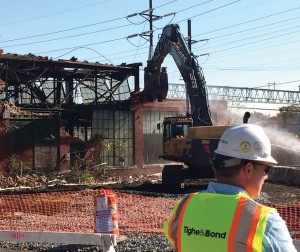Stratford”™s contaminated industrial Contract Plating site lay in decay for years but, in a matter of weeks, the main building of the site will be reduced to rubble and carted off as the town continues to take action on long-awaited remediation and reuse plans for industrial waste sites.
“This is an important day for us,” Stratford Mayor John Harkins said in front of a demolition crew at the Contract Plating site last week. “It was tax delinquent, it was contaminated, it was blighted and it was something the neighbors had to deal with for years. So we are glad to finally today start the demolition of this unsightly mess.”
The demolition of the 10.5-acre Contract Plating site was made possible through a $2.85 million grant to the town of Stratford by the state Department of Economic and Community Development in 2014 to remediate and redevelop so-called brownfield sites, former industrial or commercial locations designated as toxic and in need of cleanup.

- Tighe & Bond, the environmental consulting group for the town of Stratford, oversees the demolition of the Contract Plating site. Photo by Reece Alvarez
The Contract Plating site operated between 1936 and 1995 as a chemical plating facility whose activities resulted in the production of chemical-filled lagoons and toxic waste, including cyanide and arsenic, which pose serious environmental hazards and health risks.
The site was acquired by Stratford through a municipal tax foreclosure in March 2013.
Beyond the environmental burden, the site was a significant liability for the town, said Amy Knorr, Stratford”™s supervisor for economic development.
Christina Senft-Batoh, Stratford”™s conservation administrator, described the site as an unofficial dumping ground and recalled her fellows causing mischief at the site when she was a Stratford student.
“When I was at Bennel [High School], kids would come and take shopping carts from nearby Home Depot and throw them into the lagoons,” she said.
Demolition crews originally intended to implode the structures, Knorr said, but due to the unstable condition of the buildings the demolition needed to be conducted from the outside in.
At the demolition, Harkins was joined by Dick Whelan of the Stratford Redevelopment Agency; Mark Lewis, brownfield coordinator for the state Department of Energy & Environmental protection; and state Rep. Terry Backer of the 121st Assembly District.
Harkins thanked Backer in particular for his support of cleaning up brownfield sites.
“Terry has been a big advocate for the environment and not only Long Island Sound, but also for brownfields. He has been a real champion throughout the state and particularly here in Stratford,” he said.
Backer said the demolition and state of the Contract Plating site was hardly a unique situation in the Northeast, which continues to suffer economically from the legacy of the industrial era.
“If you don”™t just have another farm you can knock down and build on, which we don”™t, then you have to deal with what you have and what we have is this polluted legacy of bygone years that we are now faced with cleaning up and hopefully getting derelict properties back in to some productive use,” he said. “It should be very familiar rhetoric, every time we are at one of these events, whether it is here in Stratford or in Bridgeport, we are spending taxpayer dollars to get land back into productive use.”
In October, the town began the final step in the demolition of the Mercer Coal Towers, another brownfield site that, after sitting abandoned for years, was acquired by the town as a tax delinquent property and demolished using grant funds.
Getting the properties back on the tax rolls is the primary focus for Stratford officials, who hope the Contract Plating site”™s main building will be demolished by Thanksgiving with the additional structures on the property to follow on a yet to be determined timeline.
Once the demolition is complete, requests for qualifications will be issued to determine developer interest in the property and what further remediation may be required, Knorr said.
“If a developer wants manufacturing, it will not need as much cleanup as an apartment complex, that would mean more remediation, which would mean more money spent,” she said.
Whether future development of the site will be commercial, industrial or residential will be entirely market driven, Knorr said.



















